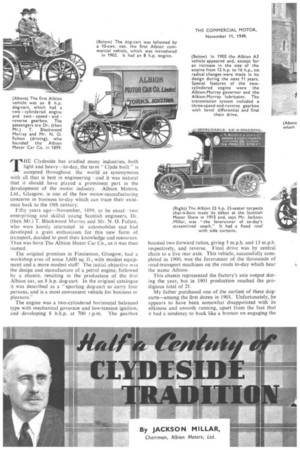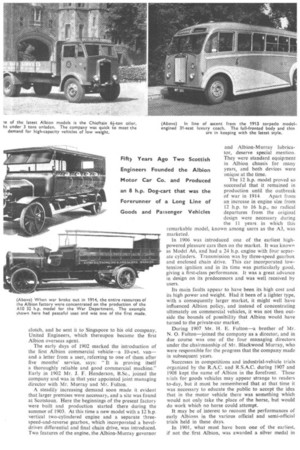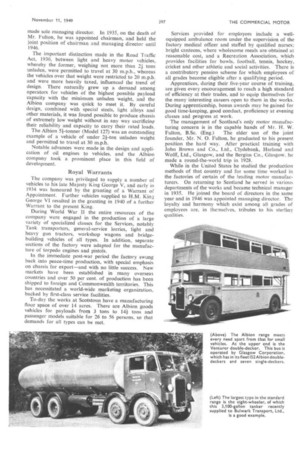T HE Clydeside has cradled many industries, both light and heavy—to-day,
Page 96

Page 97

Page 98

Page 99

If you've noticed an error in this article please click here to report it so we can fix it.
the term "Clyde built" is accepted throughout the world as synonymous
with all that is best in engineering and it was natural that it should have played a prominent part in the development of the motor industry. Albion Motors, Ltd., Glasgow, is one of the few motor-manufacturing concerns in business to-day which can trace their existence back to the 19th century.
Fifty years ago—November, 1899, to be exact—two enterprising and skilful young Scottish engineers, Dr. (then Mr.) T. Blackwood Murray and Mr. N. 0. Fulton, who were keenly interested in automobiles and had developed a great enthusiasm for this new form of transport, decided to pool their knowledge and resources. Thus was born The Albion Motor Car Co., as it was then named.
The original premises in Finnieston, Glasgow, had a workshop area of some 3,600 sq. ft., with modest equipment and a more modest staff! The initial objective was the design and manufacture of a petrol engine, followed by a chassis, resulting in the production of the first Albion car, an 8 h.p. dog-cart. In the original catalogue it was described as a " sporting dog-cart to carry four persons, and is a most convenient vehicle for business or pleasure."
The engine was a two-cylindered horizontal balanced type with mechanical governor and low-tension ignition, and developing 8 b.h.p. at 700 r.p.m. The gearbox boasted two forward ratios, giving 5 m.p.h. and 13 m.p.h. respectively, and reverse. Final drive was by central chain to a live rear axle. This vehicle, successfully completed in 1900, was the forerunner of the thousands of road-transport machines on the roads to-day which bear the name Albion.
This chassis represented the factory's sole output during the year, but in 1901 production reached the prodigious total of 21.
My father purchased one of the earliest of these dogcarts—among the first dozen in 1901. Unfortunately, he appears to have been somewhat disappointed with its silkiness and smooth running, apart from the fact that it had a tendency to buck like a bronco on engaging the clutch, and he sent it to Singapore to his old company, United Engineers, which thereupon became the first Albion overseas agent.
The early days of 1902 marked the introduction of the first Albion commercial vehicle—a 10-cwt. van— and a letter from a user, referring to one of them after five months' service, says: " It is proving itself a thoroughly reliable and good commercial machine." Early in 1902 Mr. J. F. Henderson, B.Sc., joined the company and was in that year appointed joint managing director with Mr. Murray and Mr. Fulton.
A steadily increasing demand soon made it evident that larger premises were necessary, and a site was found at Scotstoun. Here the beginnings of the present factory were built and production started there during the summer of 1903. At this time a new model with a 12 h.p. vertical two-cylindered engine and a separate threespeed-and-reverse gearbox, which incorporated a beveldriven differential and final chain drive, was introduced_ Two features of the engine, the Albion-Murray governor and Albion-Murray lubricator, deserve special mention. They were standard equipment in Albion chassis for many years, and both devices were unique at the time.
The 12 h.p. model proved so successful that it remained in production until the outbreak of war in 1914 Apart from an increase in engine size from 12 h.p. to 16 h.p., no radical departures from the original
design were necessary, during the 11 years. in which this remarkable model, known among users as the A3, was marketed.
In 1906 was introduced one of the earliest highpowered pleasure cars then on the market. It was known as Model A6, and had a 24 h.p. engine with four separate cylinders. Transmission was by three-speed gearbox and enclosed chain drive. This car incorporated lowtension ignition and in its time was particularly good, giving a first-class performance. It was a great advance in design on its predecessors and was well received by users.
Its main faults appear to have been its high cost and its high power and weight. Had it been of a lighter type, with a consequently larger market, it might well have influenced Albion policy, and instead of concentrating ultimately on commercial vehicles, it was not then outside the bounds of possibility that Albion would have turned to the private-car market.
During 1907 Mr. H. E. Fulton—a brother of Mr. N. O. Fulton—joined the company as a director, and in due course was one of the four managing directors under the chairmanship of Mr. Blackwood Murray, who were responsible for the progress that the company made in subsequent years.
Successes in competitions and industrial-vehicle trials organized by the R.A.C. and R.S.A.C. during 1907 and 1908 kept the name of Albion in the forefront. These trials for goods vehicles may appear strange to readers to-day, but it must be remembered that at that time it was necessary to educate the public to accept the idea that in the motor vehicle there was something which would not only take the place of the horse, but would do work which no horse could attempt.
It may be of interest to recount the performances of early Albions in the various official and semi-official trials held in these days.
In 1901, what must have been one of the earliest, if not the first Albion, was awarded a silver medal in the Glasgow International Exhibition 500-mile trial. It was a creditable performance to have finished at all.
A year later a 12 h.p. Albion was awarded a silver medal in the reliability trials held by the Automobile Club of Great Britain and Ireland.
In 1905, a 16 h.p. car was awarded a gold medal in the Scottish trials held by the Scottish Automobile Club.
Two years afterwards a 24 h.p. car won a silver medal in vapour-emission trials held by the Royal Automobile Club. Again, in the same year, two Albions won gold medals in the Scottish Automobile Club industrialvehicle trials, and in 1908 the 24 h.p. car won the Scottish Cup for the lowest petrol consumption in the reliability trials held by the Scottish Automobile Club.
About this time another light vehicle was introduced. It was a 15 hp model with a four-cylindered engine. three-speed "crash" gearbox and bevel-driven live axle. This model remained in production until World War I.
The Albion A3 had been developed in a range of types up to 2-ton carrying capacity, but as there was a growing demand for heavier machines, the 32 h.p. model was introduced in 1910 to deal with 3-ton and 4-ton loads. This model, known as A10 and destined to become as famous as the A3, was powered by a monobloc four-cylindered engine embodying the AlbionMurray governor and lubricator. The gearbox was a separate unit, in which the drive on all gears was through the countershaft to the differential; the drive to the rear wheels was by chain. The design was simple and the chain-drive system kept the chassis weight low.
At that time the char-a-banes was beginning to attract attention and, naturally, coach models became part of the Albion range. It may be pertinent at this point to mention the introduction at the Scottish Motor Show of 1913 of the Albion torpedo model, the first of its kind, and the forerunner of to-day's streamlined coach.
Altogether, 1913 was a most important year in the history of the company, for in November the directors decided to cease building private cars and concentrate entirely on the manufacture of commercial vehicles. A steadily growing demand for Albions at home, coupled with considerable expansion in overseas business, particularly in the Dominions and Colonies, necessitated further large extensions to the works. The beginning of 1914 witnessed the continued development of the company, and with the outbreak of war the entire resources of the factory were concentrated on the production of the 32 h.p. model for the War Department. Many thousands were supplied during the war, and their extraordinarily reliable performance is still remembered by those who operated them in Flanders, Gallipoli and on various other fronts. During the war further extensions were made to the factory.
Back to Peace
Mr. T. Blackwood Murray had been responsible for the design of Albion vehicles since the inception of the company, and his services to the engineering industry were recognized in 1917, when the degree of B.Sc. was conferred on him by Edinburgh University. Immediately after the cessation of hostilities in 1918 he set about designing an up-to-date range of goods vehicles, which was introduced at intervals up to 1926.
About this time a great expansion in the use of motorbuses began to take shape, and to meet this demand a special low-loading bus chassis was produced. This model created a favourable impression and one of the first buses completed a non-stop run from George Square, Glasgow, round Eros in Piccadilly, London, and back to Glasgow in just over 24 hours! The rapid developments in the use of pneumatic tyres for heavy goods vehicles resulted in the introduction of an entirely new range of chassis specifically designed for pneumatic tyres.
Dr. Murray's untimely death in 1929 was a great blow, not only to the company but to the motor industry in general; and the sudden death of Mr. N. 0. Fulton in 1935 removed the second of the two founders.
Mr. George Pate joined the company in 1929, under the chairmanship of Mr. N. 0. Fulton, and in 1933 was
made sole managing director. In 1935, on the death of Mr. Fulton, he was appointed chairman, and held the joint position of chairman and managing director until 1946.
The important distinction made in the Road Traffic Act, 1930, between light and heavy motor vehicles, whereby the former, weighing not more than 21 tons unladen, were permitted to travel at 30 m.p.h., whereas the vehicles over that weight were restricted to 20 m.p.h. and were more heavily taxed, influenced the trend of design. There naturally grew up a demand among operators for vehicles of the highest possible payload capacity with the minimum unladen weight, and the Albion company was quick to meet it. By careful design, combined with special steels, light alloys and other materials, it was found possible to produce chassis of extremely low weight without in any way sacrificing their reliability and capacity to carry their rated loads.
The Albion 51-tonner (Model 127) was an outstanding example of a vehicle of under 24-ton unladen weight and permitted to travel at 30 m.p.h.
Notable advances were made in the design and application of oil engines to vehicles, and the Albion company took a prominent place in this field of development.
Royal Warrants The company was privileged to supply a number of vehicles to his late Majesty King George V, and early in 1934 was honoured by the granting of a Warrant of Appointment. Further vehicles supplied to H.M. King George VI resulted in the granting in 1940 of a further Warrant to the present King.
During World War II the entire resources of the company were engaged in the production of a large variety of specialized classes for the Services, notably Tank transporters, general-service lorries, light and heavy gun tractors, workshop wagons and bridgebuilding vehicles of all types. In addition, separate sections of the factory were adapted for the manufacture of torpedo engines and pistols.
In the immediate post-war period the factory swung back into peace-time production, with special emphasis on chassis for export—and with no little success. New markets have been established in many overseas countries and over 50 per cent. of production has been shipped to foreign and Commonwealth territories. This has necessitated a world-wide marketing organization, backed by first-class service facilities.
To-day the works at Scotstoun have a manufacturing floor space of over 14 acres. There are Albion goods vehicles for payloads from 3 tons to 144 tons and passenger models suitable for 26 to 56 persons, so that demands for all types can be met. Services provided for employees include a wellequipped ambulance room under the supervision of the factory medical officer and staffed by qualified nurses: bright canteens, where wholesome meals are obtained at reasonable cost, and a Recreation Association, which provides facilities for bowls, football, tennis, hockey, cricket and other athletic and social activities. There is a contributory pension scheme for which employees of all grades become eligible after a qualifying period.
Apprentices, during their five-year course of training, are given every encouragement to reach a high standard of efficiency at their trades, and to equip themselves for the many interesting careers open to them in the works. During apprenticeship, bonus awards may be gained for good time-keeping, good conduct, proficiency at evening classes and progress at work.
The management of Scotland's only motor manufacturing concern is in the capable hands of Mr. H. W. Fulton, B.Sc. (Eng.) The elder son of the joint founder, Mr. N. 0. Fulton, he graduated to his present position the hard way. After practical training with John Brown and Co., Ltd., Clydebank, Harland and Wolff, Ltd., Glasgow, and the Bergius Co., Glasgow, he made a round-the-world trip in 192S.
While in the United States he studied the production methods of that country and for some time worked in the factories of certain of the leading motor manufacturers. On returning to Scotland he served in various departments of the works and became technical manager in 1935. He joined the board of directors in the same year and in 1946 was appointed managing director. The loyalty and harmony which exist among all grades of employees are, in themselves, tributes to his sterling qualities.
































































































































































































